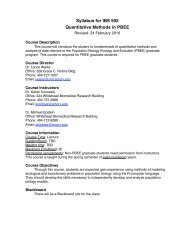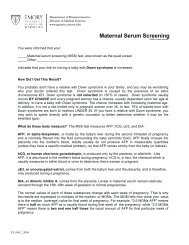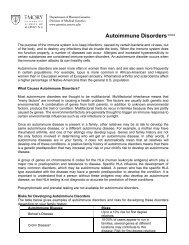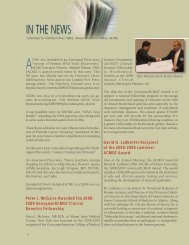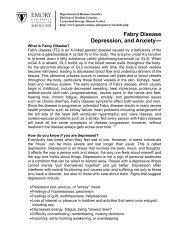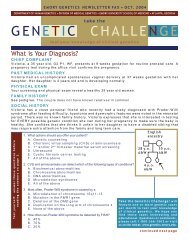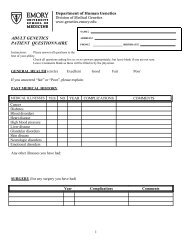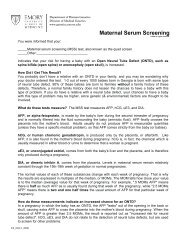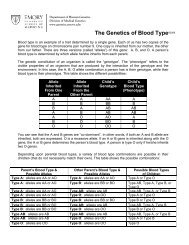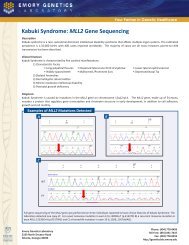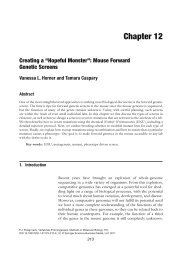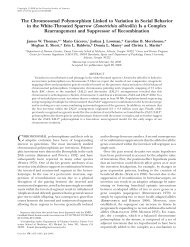EMORY GENETICS LABORATORY
EMORY GENETICS LABORATORY
EMORY GENETICS LABORATORY
Create successful ePaper yourself
Turn your PDF publications into a flip-book with our unique Google optimized e-Paper software.
<strong>EMORY</strong> <strong>GENETICS</strong> <strong>LABORATORY</strong><br />
Your Partner in Genetic Healthcare<br />
Whole Genome Cytogenetic Array<br />
EmArray 60K & 180K SNP
Emory Genetics Laboratory (EGL) is a worldwide leader with more than 35 years of expertise in comprehensive genetic<br />
diagnostic testing. Our innovation and strength in studying rare genetic conditions foster our dedication to providing<br />
the medical community with state-of-the-art tests, informative test reports and quality customer service. Our laboratory<br />
directors, genetics counselors and medical geneticists, recognized as leaders in their areas of interest, are available to<br />
discuss key issues related to diagnosis, interpretation and medical management for the conditions in our growing test<br />
menu. By integrating cutting-edge genetic testing technologies with clinical expertise, EGL provides the quality laboratory<br />
services needed to enhance the clinical care you provide to your patients.<br />
EMARRAY CYTO<br />
Whole genome cytogenetic array analysis has revolutionized the diagnostic yield of cytogenetic testing and is now<br />
recommended as the first-tier test for individuals with developmental delay, intellectual disabilities, autism or multiple<br />
congenital anomalies. In our laboratory, ~20% of individuals referred for developmental delay, mental retardation, multiple<br />
congenital anomalies, and/or autism have a clinically relevant cytogenetic imbalance detected. EGL offers two<br />
levels of array analysis:<br />
• EmArray 60K: Consists of approimately 60,000 oligos spaced at a minimum of 75 kb across the genome which can<br />
detect imbalances greater than ~250 kb.<br />
• EmArray 180K SNP: Consists of the ISCA 180K oligo design which can detect imbalances greater than ~75 kb. Also<br />
includes SNP probes to detect uniparental disomy (UPD) and apparent identity by descent.<br />
Both arrays offer high-density coverage (20-50 kb) of clinically relevant regions including all telomeres, centromeres,<br />
known microdeletion/microduplication syndrome loci, and X-linked intellectual disability genes (Baldwin et al., 2008).<br />
The 60K Array can be used for routine detection of copy number imbalances. The 180K SNP Array is indicated when a<br />
higher resolution across the genome is desired, or if UPD or identity by descent are suspected.<br />
All pathogenic imbalances are confirmed by a second methodology (usually by FISH analysis) at the time of testing or<br />
during parental testing. UPD findings are confirmed by methylation testing.<br />
25 or 75 kb interval backbone<br />
pter cen qter<br />
WHY CHOOSE EGL FOR YOUR ARRAY TESTING NEEDS?<br />
• As the founding member of the ISCA Consortium, EGL has extensive expertise in array analytics and copy number<br />
changes. By using EGL’s EmArray, your patient’s results are supported by the Consortium with standardization in design<br />
and data interpretation from more than 165 labs worldwide.<br />
• We offer first-rate results interpretation. Many companies offer array services, but EGL distinguishes itself by having<br />
over 35 years of experience in cytogenetic testing. Our laboratory is supported by an experienced team of cytogenetic<br />
and molecular laboratory directors, clinical geneticists and trained genetic counselors who are always available<br />
to address your needs and questions. Over the years, through their innovative research and rapid translation to clinical<br />
practice, EGL’s Laboratory Directors have delivered novel tests, including telomere testing by FISH and the first whole<br />
genome oligo microarrays, to the clinical genetics community. These tests and the research involved in developing<br />
them have changed the clinical approach to cytogenetic testing.<br />
• Alternative Specimen Collection Options: Dried Blood Spots<br />
- Less invasive for hard-to-draw patients<br />
- No blood draw required<br />
- Highly stable and doesn’t require special handling or shipping<br />
- As reliable as whole blood samples<br />
• Turn Around Time of 5-7 days for the EmArray 60K and 3-4 weeks for the EmArray 180K SNP.
Case 1 - The Importance of FISH Follow-up<br />
Cytogenetic array analysis was ordered on an 8 year old patient due<br />
to a clinical presentation of: multiple congenital anomalies, mental<br />
retardation, sensorineural hearing loss and microcephaly. As shown in<br />
Figure 1, array analysis identified a pathogenic 1.69 Mb interstitial deletion<br />
of 9q34.3. This deletion resulted in the loss of 60 genes, including<br />
EHMT1, which causes the chromosome 9q deletion syndrome. FISH<br />
analysis confirmed the deletion (indicated by the arrow in Figure 2).<br />
figure 2<br />
Parental studies using metaphase FISH<br />
were performed to determine whether<br />
the finding in the proband was de novo<br />
figure 1<br />
or inherited. Interestingly, as shown in Figure 3, the mother<br />
of this patient was found to carry a balanced insertional translocation involving<br />
chromosomes 7 and 9. This balanced rearrangement results in a derivative 7 chromosome<br />
with material from distal 9q and a deleted chromosome 9. This mother is<br />
therefore at increased risk to have unbalanced offspring with either the same deletion<br />
as the proband or a duplication of 9q if the derivative7 is inherited.<br />
Some labs perform parental follow-up by molecular methods, such<br />
as qPCR (quantitative PCR) or MLPA (multiplex ligation-dependent<br />
probe amplification). These methods will not detect balanced rearrangements<br />
in a parent. Because this information is crucial to providing<br />
accurate recurrence risk counseling, EGL performs all parental<br />
follow-up by FISH. This approach allows for maximum detection of<br />
clinically significant cytogenetic findings that will impact your patients’<br />
care.<br />
Case 2 - Characterization of Atypical Microdeletions<br />
Cytogenetic array analysis was performed on a 10 year old with a clinical diagnosis of Williams syndrome confirmed<br />
by FISH analysis. Previous G-banding analysis was normal. Although the patient’s history included many of<br />
the typical features of Williams syndrome, he<br />
had no language and a severe seizure disorder.<br />
Suspicious of an additional diagnosis, the clinician<br />
ordered array analysis.<br />
The array results (Figure 4) revealed that the<br />
deletion on chromosome 7q was 10.87 Mb<br />
in size, much larger than the typical Williams<br />
syndrome deletion. Determination of the true<br />
breakpoints of this deletion explained the<br />
additional phenotypic features in this child,<br />
providing better genotype/phenotype correlations.<br />
This case also demonstrates that even<br />
large deletions can be missed by G-banding,<br />
due to the location on the chromosome or<br />
subtlety of the change, providing further<br />
evidence for array analysis as a first-line cytogenetic<br />
diagnostic test. figure 4<br />
figure 3
Case 3 - Autism<br />
Autism spectrum disorders have a large genetic component<br />
and cytogenetic imbalances contribute significantly to their<br />
etiology. At EGL, we find pathogenic imbalances in ~8-10%<br />
of individuals with autism. As described in the examples<br />
below, these imbalances include recurrent deletions and<br />
duplications known to be associated with autism, as well as<br />
novel cytogenetic aberrations.<br />
A sample from a 5 year old patient with autistic features and<br />
speech delay was sent for array analysis. As shown in Figure<br />
5, a 600 kb deletion of 16p11.2 was identified.<br />
Emory Genetics Laboratory<br />
2165 North Decatur Road<br />
Atlanta, Georgia 30033<br />
figure 6<br />
Several recent publications have demonstrated that deletions of<br />
this region cause autism in ~50% of patients with this deletion<br />
(Kumar et al., 2008; Weiss et al., 2008; Marshall et al., 2008). Deletions<br />
of this region have also been reported in association with<br />
mild dysmorphic features, hypotonia, weight problems, seizures,<br />
and mild mental retardation.<br />
Another sample was received for cytogenetic array analysis from<br />
an 8 year old male referred with autism. A 17 kb deletion of part<br />
of the FMR1 gene was identified, as shown in Figure 6. Mutations<br />
in the FMR1 gene cause Fragile X syndrome and this small deletion<br />
was detected due to the increased probe coverage included<br />
on our custom array for this targeted gene. The genome browser<br />
view (Figure 7) shows the extent of this deletion.<br />
figure 7<br />
The increased sensitivity provided<br />
by cytogenetic array analysis for<br />
such predictive copy number<br />
changes allows for earlier diagnosis<br />
and earlier, more effective interventions<br />
in autism spectrum disorders.<br />
HOW TO ORDER THE EMARRAY 60K OR 180K SNP<br />
Our goal at EGL is to make the test ordering process as simple as possible for our clients. To do this, we offer<br />
three distinct ways to order tests: Specialized Cytogenetics Requisition Form, Custom Requisition Forms, and<br />
Online Test Ordering. Please contact our Client Service representatives for more information at (855) 831-<br />
7447, or visit our website at http://geneticslab.emory.edu.<br />
figure 5<br />
Phone: 404-778-8499<br />
Toll Free: 855-831-7447<br />
Fax: 404-778-8559<br />
http://geneticslab.emory.edu




